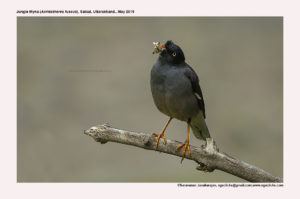
Jungle Myna Acridotheres fuscus
Habitat:
- Acridotheres : Greek word akris- locust; theras–hunter { Locust hunter}
- Fuscus : Latin word for Brown colour
Vernacular names: Hindi: Pahari/Junglimyna, Sans: Aranyasaarika, Pun: Janagligutar, Ben: Jhontsalik, Junglisalik, Guj: Vanakabar, Mar: Junglimyna, Ta: Kattumyna, Te: Adavigorinka, Mal: Kinnarimyna,Kan: Kadugoravanka
Distribution in India: Widespread Resident in Himalayas, East, North East, parts of Tamilnadu and Western Ghats.
Description: Size of 22-23cm; wt. of 72–98g. The forehead to nape, neck and cheek are glossy black; upperparts brownish-charcoal, paler on rump; wing brownish-black, bronze wash on coverts, white bases of primaries covering about half length of inner primaries; tail brownish-black, retrices tipped white, broader white band on outer feathers; chin, throat and breast slaty grey, belly paler and tinged buff (particularly on lower belly), under tail-coverts white; iris yellow; bill orange, bluish-black base of lower mandible; legs waxy orange . Both sexes look similar. The juvenile is browner than adult, crown feathers less hackled and less glossy, wings and tail are also browner, less distinct white tips on rectrices, browner below, throat is pale, breast and belly feathers are dark-centred with pale margins, producing streaked effect. The race mahrattensis is browner than nominate, with iris bluish-white or grey; race fumidus is darker, sooty-coloured, with iris yellow; racetorquatus has longer and more glossy crown hackles, darker flanks and belly, off-white undertail-coverts.
Habitat: It is found in forest edge and clearings, deciduous woodland near open areas, including cultivated lands, tea plantations, villages and coastal plains; primarily in lowlands and foothillsup to 2000 m in Himalayas
Food Habits: It is omnivorous, diet incorporating animal food, fruit, seeds, and food waste discarded by humans. Animal food includes frog tadpoles, small snails, earthworms, ticks, spiders, ants and wasps and other small insects. Fruits eaten include figs, grapes, mulberries, peas and chilies. Occasional feeds on nectar. It forages largely on ground, especially in grasslands grazed by cattle; frequently perches on cattle, and hawks insects disturbed by them. It uses open-bill probing to collect insects in grass. Sometimes feeds in trees and bushes, when food sources abundant there. It is seen commonly in flocks; also in pairs
Breeding Habits: They breed in Apr–July in Northern parts of India and Feb-May in Southern Parts of India. They are Monogamous and colonial breeders. The nest a simple structure lined with twigs, roots, feathers and human artifacts, often sloughed snake skins included, placed in hole in tree, sometimes old hole of Woodpecker. They lay a clutch of 3–6 eggs. The incubation is done by both sexes, female doing more for a period 13 day. Both parents feed chicks and remove fecal material. The nestling period is for 20–22 days.